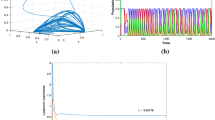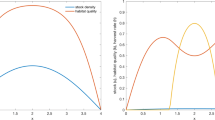Abstract
Interactions between trophic and halieutic populations, have often been ignored in most mathematical models that are interested in prey–predator dynamics. However, the presence of vegetation in hydraulic environments, is important, and it has a direct impact on the life cycle of many fishes. In fact, aquatic populations are essential for providing oxygen, food and also shelter for grazers. For this, we suggest a mathematical and optimization approach, in an attempt to discuss the possibility of finding effective harvesting control strategies that aim to optimize the fishing efforts without affecting the trophic-halieutic populations and compromising with the interests of fishermen. The model is in the form of three ordinary differential equations, and which describes dynamics of multi-species of a fishery that includes grazer–predator fishes and aquatic plants, during fishing periods. We study the stability of the proposed differential system, and we suggest harvesting optimal control approaches for the environmental sustainability and bioeconomic cases after the introduction of two control functions in the model and which represent the efforts of fishing in grazer and predator populations respectively. The two optimal controls are characterized in the first case, based on Pontryagin’s maximum principle, and we seek their analytical formulations in the second case, when they are singular functions. Hence, these two optimal control approaches lead to two two-point boundary value problems which are resolve numerically based on the forward-backward sweep method with the incorporation of iterative Runge-Kutta fourth order progressive-regressive schemes.






Similar content being viewed by others
References
Auger P, Kooi BW, de La Parra RB, Poggiale JC (2006) Bifurcation analysis of a predatorprey model with predators using hawk and dove tactics. J Theor Biol 238(3):597–607
Chapin F III, Stuart Erika S, Zavaleta Valerie T, Eviner Rosamond L, Naylor Peter M, Vitousek Heather L, Reynolds David U, Hooper et al (2000) Consequences of changing biodiversity. Nature 405(6783):234–242
Clark CW (1985) Bio-economic modelling and fisheries management. Intersciences, University of California, Oakland, CA
Clark CW (1990) Mathematical bioeconomics: the optimal management of renewable resources, 2nd ed. A Wiley-Interscience, University of Michigan, Ann Arbor, MI
Dayton Paul K, Thrush Simon, Coleman Felicia C (2003) Ecological effects of fishing. Report to the Pew Oceans Commission, Arlington
Dulvy NK (2006) Extinctions and threat in the sea. Oceanologica Acta 23:485–496
Elmouki I, Saadi S (2015) Quadratic and linear controls developing an optimal treatment for the use of BCG immunotherapy in superficial bladder cancer. Optim Control Appl Methods. doi:10.1002/oca.2161
Fleming WH, Rishel RW (1975) Determenistic and stochastic optimal control. Springer, New York
Gordon HS (1953) An economic approach to the optimum utilization of fisheries resources. J Fish Res Board Canada 10:442–457
Ji L, Wu C (2010) Qualitative analysis of a predator-prey model with constant-rate prey harvesting incorporating a constant prey refuge. Nonlinear Anal Real World Appl 11:2285–2295
Kar TK, Chaudhuri KS (2002) On non-selective harvesting of a multispecies fishery. Int J Math Educ Sci Technol 33(4):543–556
Kar TK, Misra S, Mukhopadhyay B (2006) A bioeconomic model of a ratio-dependent predator-prey system and optimal harvesting. Int J Dyn Control 22(1/2):387–401
Lenhart S, Workman J (2007) Optimal control applied to biological models. Chapman Hall/CRC, Boca Raton
Lukes D (1982) Differential equations: classical to controlled. Academic, New York
Pontryagin LS, Boltyonskii VG, Gamkrelidre RV, Mishchenko EF (1962) The mathematical theory of optimal processes. Wiley, NewYork
Sahrhage D, Lundbeck J (1992) A history of fishing. Springer, Berlin, Heidelberg
Santra P, Mahapatra GS, Pal D (2016) Prey–predator nonlinear harvesting model with functional response incorporating prey refuge. Int J Dyn Control 4(3):293–302
Schaefer MB (1954) Some aspects of the dynamics of populations important to the management of the commercial marine fisheries. Bull lnter Am Trop Tuna Comm 2:27–56
Acknowledgements
The authors would like to thank the Editor and all members of the Editorial Board who were responsible of this paper, and also, the anonymous referees for their valuable comments to improve the content of this research paper.
Author information
Authors and Affiliations
Corresponding author
Rights and permissions
About this article
Cite this article
Chouayakh, K., Rachik, M., Satori, K. et al. Trophic and halieutic dynamics of grazer–predator fishes: harvesting optimal control policies for the environmental sustainability and bioeconomic cases. Model. Earth Syst. Environ. 3, 567–580 (2017). https://doi.org/10.1007/s40808-017-0318-8
Received:
Accepted:
Published:
Issue Date:
DOI: https://doi.org/10.1007/s40808-017-0318-8




